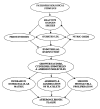Pathogenesis of atherosclerosis: A multifactorial process
- PMID: 19644578
- PMCID: PMC2716189
Pathogenesis of atherosclerosis: A multifactorial process
Abstract
Atherosclerosis is a leading cause of mortality and morbidity in the western world. It has been recognized for over a century, and the understanding of its pathogenesis has undergone many changes. Pathophysiological studies have unravelled the interactions of molecular and cellular elements involved in atherogenesis. The focus has shifted to the novel risk factors as well as characteristics and stability of atherosclerotic plaque; the genetic predisposition has further broadened the pathogenetic mechanisms. This review focuses on the molecular mechanisms involved in the evolution of the atherosclerotic plaque that may pave the way for selecting optimal therapies and preventing plaque complications. Atherosclerosis is no longer a disease attributed mainly to the high lipid content of the body. New insight into the disease pathology has shown it to be a disease of much greater ramifications. Endothelial damage and reactive oxygen species (and other free radicals) have predominantly emerged as factors in virtually all pathways leading to the development of atherosclerosis due to hyperlipidemia, diabetes, hypertension or smoking. Novel risk factors such as hyperhomocysteinemia, infections and systemic lupus erythematosus have emerged. Atherosclerosis has come to be regarded as a chronic inflammatory disease with an autoimmune component. The genetic basis of the disease assumes significance as candidate genes are identified and gene therapy becomes a promising new addition to the existing, less substantial conventional therapies.
Keywords: Angiotensin; Atherogenesis; Cytokines; Growth factors; Oxidized low density lipoproteins; Plaque formation; Reactive oxygen species.
Figures


References
-
- Hegele RA. The genetic basis of atherosclerosis. Int J Clin Lab Res. 1997;27:2–13. - PubMed
-
- Turunen MP, Hiltunen MO, Yla-Herttuala S. Gene therapy for angiogenesis, restenosis and related diseases. Exp Gerontol. 1999;34:567–74. - PubMed
-
- Libby P, Schoenbeck U, Mach F, Selwyn AP, Ganz P. Current concepts in cardiovascular pathology: the role of LDL cholesterol in plaque rupture and stabilization. Am J Med. 1998;104:14S–8S. - PubMed
-
- Palinski W, Napoli C. Pathophysiological events during pregnancy influence the development of atherosclerosis in humans. Trends Cardiovasc Med. 1999;9:205–14. - PubMed
-
- Napoli C, D’Armiento FP, Corso G, et al. Occurrence of the same peroxidative compounds in low density lipoprotein and in atherosclerotic lesions from a homozygous familial hypercholesterolemic patient: a case report. Int J Cardiol. 1997;62:77–85. - PubMed
LinkOut - more resources
Full Text Sources
Other Literature Sources
